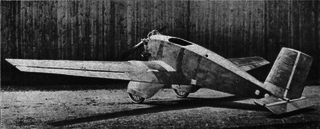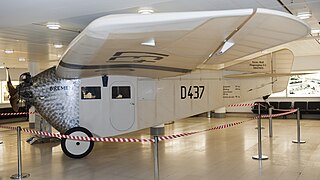
The Focke-Wulf Fw 44 Stieglitz (Goldfinch) is a twin-seat biplane designed and produced by the German aircraft manufacturer Focke-Wulf. It was the company's first major international success.
IVL C.24 was the first aircraft to be designed in Finland and built in an industrial environment. The aircraft was manufactured by IVL, but only in one example.

The Albatros L 59 was a single-seat German utility aircraft of the 1920s. It was a single-engine low-wing cantilever monoplane with large, spatted wide track undercarriage attached, unusually for the time not to the fuselage but to the wing roots. The whole aircraft was covered in 3-ply.
The Albatros L 60 was a two-seat German utility aircraft of the 1920s developed from the Albatros L 59. It was a single-engine low-wing cantilever monoplane with large, spatted undercarriage.

The Albatros L 68 Alauda was a two-seat German trainer aircraft of the 1920s. It was a single-engine biplane of conventional configuration that seated the pilot and instructor in tandem, open cockpits. The wings were of unequal span and had a pronounced stagger.

The Albatros L 82 was a 1920s German trainer biplane. Of conventional configuration, it seated the pilot and instructor in separate, open cockpits. The wings were single-bay, equal-span, and unstaggered.

The Arado S I was a biplane trainer built in Germany in 1925. The first of three prototypes was powered by a Bristol Lucifer radial engine, while the other two Arado S.Ia aircraft were fitted with the Siemens-Halske Sh 12. The Siemens-Halske Sh 11 powered the Arado S III, a virtually identical aircraft of which only a single prototype was constructed and sold to Turkey.

The Dornier Libelle, also designated Do A, was a German open-cockpit, all-metal, parasol wing, monoplane flying boat aircraft, with partly fabric-covered wings. There was three versions of the seaplane version; the prototype, first version, and improved version. A landplane version, built without sponsons and fitted with a fixed tailwheel undercarriage was produced as the Dornier Spatz.

The Focke-Wulf A.16 was a German three/four passenger light transport monoplane designed by Heinrich Focke and Georg Wulf and was the first design built by the newly formed Focke-Wulf company.

The Focke-Wulf S 2 was a trainer aircraft built in Germany in the late 1920s. It was a conventional parasol-wing monoplane with fixed tailskid undercarriage. The pilot and instructor sat side by side in an open cockpit. Only a single example was built.

The Heinkel HD 32 was a trainer developed in Germany in the 1920s, a derivative of the HD 21. Like that aircraft, it was a conventional, single-bay biplane, but had only two cockpits rather than the three that the HD 21 had. The other significant change was the use of a Siemens radial engine in place of the inline units that powered most of the HD 21 family.

The Junkers K 16 was a small airliner produced in Germany in the early 1920s. It was a conventional, high-wing cantilever monoplane of all-metal construction, equipped with fixed, tailwheel undercarriage. The pilot sat in an open cockpit, while the two passengers were provided with an enclosed cabin within the fuselage. Shortly after the prototype flew, aircraft production in Germany was brought to a complete halt by the Allies, and the K 16 was quickly evacuated to the Netherlands to avoid confiscation. There, it was stored by Fokker until the restrictions were relaxed and work recommenced at Junkers' Dessau factory in 1924. By this time, however, the airline niche that the tiny K 16 had been intended to fill no longer existed, and the small number that were produced were mostly sold to private owners. Junkers entered two K 16s in the 1925 Deutsche Rundflug, with one machine winning second place in the competition.
The SIM-VIII was a 1931 Yugoslav, single-engined, 2-seat, sport, tourist and training aircraft, designed by Sima Milutinović and built at the Rogožarski factory in Belgrade from 1931 and by Ikarus at Zemun from 1933.

The Darmstadt D-29 was a German experimental monoplane designed and built by Akaflieg Darmstadt. The D-29 was a cantilever low-wing monoplane designed and built during 1936 with a conventional landing gear with a tailskid. It was powered by a Siemens-Halske Sh 14a radial piston engine and had enclosed tandem cockpits, as well as a number of other features, including hydraulically actuated trailing-edge flaps, a braced T-tail and leading-edge slots.

The LFG V 40 and V 44 were one-off, single-engine, two-seat sports monoplanes, identical apart from their engines, built in Germany in 1925.

The Albatros L.71 was a two-seat, single pusher engined biplane built in Germany in the 1920s.

The Udet U 1 was the first of a line of small, low-powered, low wing, cantilever monoplanes built in Germany in the early 1920s.
The Dietrich-Gobiet DP.VII was a simple, low power, German sports aircraft flown in early 1924.

The parasol wing, single engine Udet U 8, sometimes referred to as the Limousine, was a three-seat commercial passenger transport designed and built in Germany in 1924. Five were produced and were used by German airlines until about 1928.

The Klemm L 26, later Klemm Kl 26, was a low-wing trainer aircraft built by Klemm.
















